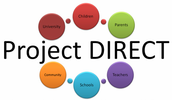Usually, the kids are able to have two blocks of time in the classroom- one devoted to a group activity (such as writing sentences, using sight words, or practicing their names and letters) and one devoted to centers, where they are able to choose between various activities such as rhyming games or using play-doh to make letters.
I've loved being able to see the kids on a weekly basis, because I've noticed that every time I visit they are getting better and better at skills such as writing their names and learning sight words. When I first started, they were just finishing their letters and numbers- now, they are able to read some words, write their full names, and even count to 100. I'm excited to see where they will be by the end of the year!


 RSS Feed
RSS Feed